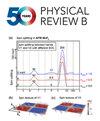Untangling the Raman spectra of cubic and tetragonal BaZrO3
IF 3.7
2区 物理与天体物理
Q1 Physics and Astronomy
引用次数: 0
Abstract
Raman spectroscopy is a widely used experimental technique to study the vibrational properties of solids. Atomic scale simulations can be used to predict such spectra, but reliable studies at finite temperatures are challenging, mainly due to the requirement of accurate and computationally efficient models for the dielectric susceptibility. Here, we have used molecular dynamics simulations together with a density functional theory-based model for the dielectric susceptibility to determine the Raman spectrum of barium zirconate, BaZrO3 (BZO), a well-studied oxide perovskite. At ambient conditions, where the system is cubic, we find excellent agreement with experimentally measured Raman spectra. Our study establishes that the relatively sharp spectra seen experimentally are due to second-order scattering. At higher pressures, where BZO is tetragonal, all first-order Raman active modes are identified. Additionally, slightly below the phase transition, in the cubic phase, a broad central Raman peak appears. The origin of this type of peak is controversial and extensively debated in connection with the dynamics of the halide perovskites. Here, we show that it is also present in a hard oxide perovskite, and it originates from the highly overdamped R-tilt mode in the cubic structure.求助全文
约1分钟内获得全文
求助全文
来源期刊

Physical Review B
物理-物理:凝聚态物理
CiteScore
6.70
自引率
32.40%
发文量
0
审稿时长
3.0 months
期刊介绍:
Physical Review B (PRB) is the world’s largest dedicated physics journal, publishing approximately 100 new, high-quality papers each week. The most highly cited journal in condensed matter physics, PRB provides outstanding depth and breadth of coverage, combined with unrivaled context and background for ongoing research by scientists worldwide.
PRB covers the full range of condensed matter, materials physics, and related subfields, including:
-Structure and phase transitions
-Ferroelectrics and multiferroics
-Disordered systems and alloys
-Magnetism
-Superconductivity
-Electronic structure, photonics, and metamaterials
-Semiconductors and mesoscopic systems
-Surfaces, nanoscience, and two-dimensional materials
-Topological states of matter
 求助内容:
求助内容: 应助结果提醒方式:
应助结果提醒方式:


